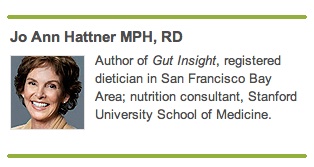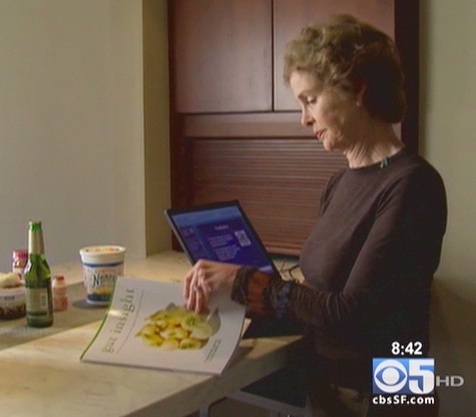|
Press
Buy
|
 |
Press on Gut Insight and Featuring Jo Ann Hattner
August 2019

This interview with Jo Ann appears in the Clinical Guide to Probiotic Products - Newsletter August 2019: Getting Our Gut Inisght. Jo Ann’s teaching and writing conveys her belief that “gut health improves overall health.”
There's a Microbe in My Dish! The Science of Longevity Issue. Cenntenial Health, Ann Marie O'Connor, editor. 2019 Jo Ann Hattner interviewed on should I take a probiotic supplement.
Food & Fitness after 50: Foods for a Healthy Gut. Chris Rosenbloom: Part 2 August, 2018 Link
In a second interview with Jo Ann Hattner, we get down to the application of prebiotics, probiotics, and fermented foods. And, we’ll dispel some myths about pre-and probiotic foods.
Food & Fitness after 50: Foods for a Healthy Gut. Chris Rosenbloom: Part 1 July 2018, Link
We hear a lot about gut health, probiotics, prebiotics and foods that contain them, but it seems like there are more questions than answers on what it means to have a healthy gut. When I talk to older adults, gut health is bound to come up. I sat down with a gut health expert, Jo Ann Hattner, to ask some questions and seek clarity.
Dead Bacteria – Despite Potential for Benefit – Are Not Probiotics July 11, 2018 • Re-posting of a blog initially published on www.usprobiotics.org on July 5. By Dr. Mary Ellen Sanders Link
At the 2018 International Scientific Association of Probiotics and Prebiotics (ISAPP) meeting in Singapore, two renowned speakers reported unpublished research documenting the health benefits of dead bacteria. Both professors made the point that these microbial preparations were not probiotics.
Prebiotics' Role in Treating Lactose Intolerance — What Dietitians Need to Know By Constance Brown-Riggs, MSEd, RD, CDE, CDN Today's Dietitian Vol. 19, No. 7, P. 18 Link
Probiotics are available in dietary supplements and yogurts, as well as in suppositories and creams.4 The FDA defines yogurt as a fermented dairy product derived from the fermentation of milk by two species of bacterial cultures: Streptococcus thermophilus and Lactobacillus bulgaricus.10 "The two starter cultures [S thermophilus and L bulgaricus] used to make yogurt produce β-galactosidase, which aides in lactose digestion in the gut," says Jo Ann Hattner, MPH, RDN, of Hattner Nutrition in San Francisco and coauthor of Gut Insight: Probiotics and Prebiotics for Digestive Health and Well-Being. "That's why people who are lactose intolerant can often tolerate eating yogurt more than drinking milk," Hattner says.
Probiotics: Probiotic Beverages By Sherry Coleman Collins, MS, RDN, LD Today's Dietitian Vol. 19, No. 4, P. 20 Link
Hattner interview excerpt:
Jo Ann Hattner, MPH, RD, coauthor of Gut Insight: Probiotics and Prebiotics for Digestive Health and Well-Being recommends referring to the Clinical Guide to Probiotic Products, available for free at usprobioticguide.com.2 The online reference lists probiotic foods, beverages, and supplements, as well as the probiotic strains they contain; ranked research based on strength; and recommended dosage. Hattner emphasizes that probiotics aren't just good bacteria but good bacteria that have been clinically proven to provide benefit to the host.
Welcome to the World in Your Gut. By Melissa Pandika | June 20, 2016 | Rally Health Link
Hattner interview excerpt:
When it comes to supplements, buyer beware. It’s unclear whether supplements work as well as probiotics in food. But since supplements don’t fall under FDA regulation, they “can be very concerning to someone with serious health conditions,” says Hattner. They can also be pricey, and “what’s on the label might not necessarily be what’s in the product.” For instance, a supplement label might state that the product contains 10 billion cultures — but they might be freeze-dried, and only a small fraction may “wake up” in the body.
Think about prebiotics. Probiotics alone may not be enough — “you have to feed them,” Hattner says. Called “prebiotics,” the food for probiotics is mainly fiber. Plus, research has already linked a high-fiber diet to a host of health benefits, including lower cholesterol levels, better control of blood sugar levels, and more regular bowel movements. Some examples of prebiotic-rich foods include garlic, onions, leeks, bananas, whole grains and flaxseed.
Guest Jo Ann Hattner, MPH, RD, dietitian and author of Gut Insight: probiotics and prebiotics for digestive health and well-being, describes foods that nourish and protect gut microorganisms Podcast Link
Dry bean Quarterly Vol. 5, No. 4 Winter 2015. Two articles by Jo Ann Hattner Link:
Feeding Your Microbes For a Healthy GI Tract
"Gut health" is a term increasingly used in the medical literature and by the food industry. It covers multiple positive aspects of the gastrointestinal (GI) tract, such as the effective digestion and absorption of food, the absence of GI illness, normal and stable intestinal microbiota, effective immune status, and a state of well-being.
Fear of Fermentation
If you want to tolerate beans, you need to eat beans. Studies demonstrate tolerance to beans is established with frequent ingestion of beans.
Weight-Loss Superfood: 6 Tips for a Healthy Gut. Live Science. Katherine Tallmadge, M.A., R.D. October 25, 2014 Link
"Together, probiotics and prebiotics are an important duo. In addition, prebiotic fibers are components of the healthiest foods on the planet — natural ...
"Ingesting prebiotics is a practical way of manipulating the microbiota, since they support and increase the beneficial bacteria population in the gut," Hattner added. "Together, probiotics and prebiotics are an important duo. In addition, prebiotic fibers are components of the healthiest foods on the planet — natural plant foods."
Pre- and Probiotic Foods: Eating for a Healthy Gut. Paper by Jo Ann Hattner and Susan Anderes. San Francisco Medicine. September 2014 Link
Physicians have the opportunity to encourage patients to nurture their gut microbiota by eating a diet rich in probiotics and prebiotics. The probiotics add live, active, healthful bacteria while prebiotic fermentable fibers feed the beneficial gut bacteria providing fuel and nutrients.
Hattner JAT, Anderes S. Pre- and Probiotic Foods: Eating for a Healthy Gut. San Franc Med. 2014 Sept;87(7) p 28-29 Link
Blender binge: Are blender nutrition claims true? Ben Popken, NBC News. Aug. 16, 2014. Link
It’s not as simple as breaking down the cell walls, said Stanford University nutritionist Jo Ann Hatter. What actually breaks the bonds between food molecules are the digestive enzymes in your stomach.
"If we needed those kinds of blades we would have those in our digestive system," said Hattner.
Dishes for Digestive Health. Martha Rose Shulman. May 9, 2014. Link
But I’d never heard the word “prebiotics” until I attended a talk by the Stanford nutritionist Jo Ann Hattner, who has written (with Susan Anderes) an interesting guide called “Gut Insight: Probiotics and Prebiotics for Digestive Health and Well-Being.”
Eat McDonald's for 3 months, lose 37 pounds? Bruce Horovitz, USA TODAY January 6, 2014
Science teacher goes on McDonald's-only diet to prove it's not where you eat, but what you eat (and how much you exercise) that matters.
Jo Ann Hattner, a nutritional consultant at Stanford University School of Medicine, says McDonald's has much improved its menu. "You have to give them some credit," she says.
But, she notes, "I don't advise a McDonald's diet," she says. "You need more fresh vegetables and fresh fruits."
Healthy eating habits often start at your desk at work. San Francicso Chronicle. Meredith May. Updated 3:30 pm, Friday, January 3, 2014 sfgate.com
When we are mindless at mealtime, we chew faster, which can lead to a host of digestion problems, says Jo Ann Hattner, a registered dietitian at Stanford Medical School. She is working on a study of participants who overwhelmingly eat on the run and at their desks.
"We are multitasking our way to bloating, gas, indigestion and irritable bowel syndrome," Hattner says.
Beyond the Headlines. June 14, 2013. What's in Our Food. Hosted by ABC7's Cheryl Jennings. Video Link
In this week's episode of "Beyond the Headlines," we talk about the possible dangers in the food that comes from our oceans and that is grown on land, as well as what you could do to create a healthier diet for yourself and your family.
Jo Ann Hattner's interview on what to eat appears at 5 minutes 50 seconds into the video.
Gut-brain connection a 2-way street, researchers find by Sheah Rarback 06.19.13 Link
I’ve got a tip on a mind-altering substance that is inexpensive, legal and readily available. UCLA researchers demonstrated that the beneficial bacteria in yogurt altered brain function during tasks and rest.
Published in the June issue of Gastroenterology and funded by the yogurt maker Danone, this small study was a first to show that the gut-brain connection is a two-way street.
Balancing Act: A Cyclist's Guide to Probiotics in Bicycling Magazine by Allison Young. February 2013. Link
When a battle in your belly threatens to disrupt your ride, probiotics are key to calling a truce.
Stool Gazing by Jo Ann Tatum Hattner In: Food and nutrition magazine from the Academy of Nutrition and Dietetics. Tuesday, October 30, 2012 Link
When it comes to nutrition and wellness counseling, taking the taboo out of number 2 can give insight into a persons's health and lifestyle.
HealthWatch: Is Greek Yogurt Really Better For You? CBS News Story and Video Link
Hattner says: All yogurt is made by fermenting milk with two active bacteria cultures: L. Bulgaricus and S. Thermophilus. Hattner said that the more of these live active cultures that you find in yogurt; the better it is for a healthier gut.
Stanford Medical School 1:2:1 podcast: Prebiotics, probiotics and the digestive system. Link
Dietician and nutrition consultant Jo Ann Hattner, RD, discusses her new book, Gut Insight, and the effects of prebiotics and probiotics on digestive health.
UCSF scientists declare war on sugar in food www.sfgate.com 2/2/12 Link
"When you get into this argument about sugar in the diet, you also have to look at the type of food that has a high sugar content," said Jo Ann Hattner, a San Francisco registered dietitian who teaches nutrition courses at Stanford. "Those foods have few nutrients and little fiber, and that's not good for you. So is it sugar itself that's harmful?" That said, Hattner added, there's no doubt that people in general consume too much sugar and that everyone could benefit from eating less - and especially looking out for "hidden" sugars in their diets.
What If I Ate Only One Type of Food? by Natalie Wolchover, Life's Little Mysteries Staff Writer. 27 January 2012 Link
"... what would actually happen if you ate only one type of food for your entire life? Depends on the poison you pick, but poison it most likely would be. According to Jo Ann Hattner... choosing to eat only one fruit, vegetable or grain would lead to organ failure. Consuming only meat would eventually force your body to start munching on your own muscles. And if you stuck solely to almost any one food (besides fruit), you would develop a serious case of scurvy."
USA Swimming TOP FIVE FOODS TO BOOST IMMUNITY 1/24/2012 BY CHRIS ROSENBLOOM, PHD, RD, CSSD Link
Winter brings more than its share of cold and flu viruses. The average young person gets anywhere from 6 to 10 colds a year, and the dry heat of winter air and close proximity to others means it is easier to spread those nasty germs. Instead of heading to the medicine cabinet, try the kitchen cabinet to find foods rich in the nutrients that keep your immune system strong all winter long.
Probiotic foods (those foods that contain good bacteria for a healthy gut) can enhance immunity. Your guts contain 2 to 3 pounds of bacteria and emerging research shows that the type of bacteria that live in your gastrointestinal tract can prevent disease by acting as a natural antibiotic. Registered dietitian Jo Ann Hattner, author of Gut Insight (www.gutinsight.com) points out that 70% of our immune function takes place in the gut so eating foods rich in probiotics is a good idea to stay healthy.
Stanford nutritionist offers tips for eating healthy during the holidays. December 23rd, 2011 Link
‘Tis the season to eat, drink and be merry. ... asked Stanford nutritionist Jo Ann Hattner, RD, for some tips and tactics on eating healthy during the holidays. Hattner shares her thoughts here.
Kids Nutrition (Part 4): Is Your Child’s Gut Healthy? — Maryann Tomovich
Jacobsen, MS RD. Raise Healthy Eaters Blog. July 22, 2011. Link
In her book, Hattner discusses how probiotic microorganisms stimulate the
immune system and increase the acidity of the gut so undesirable bacteria can’t
grow.
Stanford nutritionist offers guidelines for eating healthy on the go. July
14, 2011. scopeblog.stanford.edu
Being health-conscious when traveling can be difficult since food choices
along the interstate and in airports are limited. What are some general guidelines
travelers can use to eat healthy on the road?
Starbucks, other marketers go huge with healthier offerings. Bruce Horovitz,
USA TODAY July 12, 2011 Link
But the very notion of food marketers trying to make food healthier — and
lower in calories — is huge, says Jo Ann Hattner, nutrition instructor
at Stanford University, who is enamored of the Starbucks Bistro Boxes. "If
you're on the run, it's so much better than grabbing a giant slice of pizza."
Digestive Health: The Experts Weigh In featuring Jo Ann Hattner. www.everydayhealth.com.
June 2011. Link

|
How Helpful Are Probiotics for Digestion? Link
Why Is Fiber Important in Digestive Health? Link
What Can I Eat to Improve Digestion? Link
What Can You Do to Prevent Colon Cancer? Link
|
Fermenting Revolution. News segment featuring Jo Ann Hattner. CBS5 San Francisco
Aired on Saturday, Apr 16, 2011.

Keep your colon healthy with the right foods. MiamiHerald.com. Friday, 03.11.11
Lidia Dinkova.
"Greens predominate a high-fiber diet. According to Hattner, artichokes, asparagus,
leeks and dandelion greens are considered “prebiotic stars’’ along
with bananas, onions, garlic and Jerusalem artichokes."
SuperKids Nutrition interview with Jo Ann Hattner
We spoke with nutrition expert Jo Ann Tatum Hattner, MPH, RD to hear why probiotics
should be included in a child’s diet. Based on her pediatric practice
and current research from her book Gut Insight, you’ll learn just how
easy it is for your children to reap the health benefits for their growing
immune systems.
Holiday
Foods and Pregnant Women - a video interview with Jo Ann Hattner. Link
Jo Ann Hattner discusses holiday foods that pregnant women
should approach with caution or thorough cooking on a segment with Dr. Kim Mulvihill
for CBS 5 Healthwatch.
WebMD: Yogurt Goes Gourmet
quotes Jo Ann Hattner on probiotics.
"Yogurt’s live and active cultures contribute
friendly bacteria that promote digestive health by settling an upset stomach,
promoting regularity, and possibly boosting immunity says Jo Ann Hattner, RD,
author of Gut Insight."
A nationwide campaign, developed by the National Fruit and
Vegetable Alliance five years ago, has so far proved to be ineffective. San
Francisco-based nutritionist Jo Ann Hattner comments.
Sticky fingers among dietitians'
pet peeves by Sheah Rarback, Miami Herald.
We all have pet peeves, and some are profession-specific.
You might be surprised to learn what raises a dietitian's hackles.
We don't jump in front of strangers at the grocery store and
demand they remove the triple-fat cupcakes from their cart
or stealthily replace their white bread with whole wheat. But
that's not to say we don't have our supermarket triggers. San
Francisco dietitian Jo Ann Hattner, author of Gut Insight (gutinsight.com)
hates to see people pick through fruit, then toss back and
bruise the pieces they don't want. Appearance aside, bruised
fruit with broken skin can make a more attractive home for
bacteria, though it's generally safe to eat. (Just cut off
the brown spots, chop the unblemished fruit and add it to a
salad).
’Tis the Season
for Good Digestive Health by Maggie Moon, MS, RD Today’s Dietitian
Vol. 11 No. 11 P. 28 Link
Hattner: “natural fiber sources are abundant, why not use natural foods?”
Yogurt, Probiotics and Your "Gut
Health" from Probiotics: News You Can Use, Dannon Probiotics Center. An
interview with Jo Ann Hattner, MPH RD
Nutrition Month 2010: Want Something Good for Your Gut? Try Onions. HealthCastle.com
Let's get straight to the
-- healthy -- gut by Sheah Rarback, Miami Herald
"Colon cuisine'' might not be Zagat-rated, but it is
what Hattner thinks we need for better digestive health.
HealthWatch: Probiotics,
WCBS-TV New York. Kim Mulvihill, MD, interviews Jo Ann Hattner on KPIX (CBS
News, San Francisco Bay Area)
Hattner advises if you add probiotic foods to your
diet you should add other foods called prebiotics as well. "The prebiotics
are in the plant foods," ...
Science group ‘clarifies’ probiotics
definition by Lorraine Heller, 25-Jun-2009 foodnavigator-usa.com
The International Scientific Association for Probiotics and Prebiotics (ISAPP)
has released a “clarified definition” of the term ‘probiotic’,
which it says will help manufacturers and regulators ensure the proper use
of the bacteria.
Probiotics: can friendly bacteria
improve skin health? Interview with Jo Ann Hattner,
MPH RD on www.optiderma.com.
Posted on May 22, 2009 by Joséphine Toulemonde. Link
Probiotics, live microorganism in our gut commonly referred to as “beneficial
or friendly bacteria”, are well known to enhance immunity and digestive
health. A variety of foods are now enhanced with probiotics as well as prebiotics,
the fuel for the beneficial bacteria in our gut, for their positive health
results. What about their effect on skin?
Beneficial Bacteria? 7 Amazing
Jobs Your Gut Bacteria Do US News and World Report
By Katherine Hobson Feb 2,
2009 Link
"Trillions of microbes live inside you. But don't be frightened; some
bacteria do good things.
|
 |
 |



